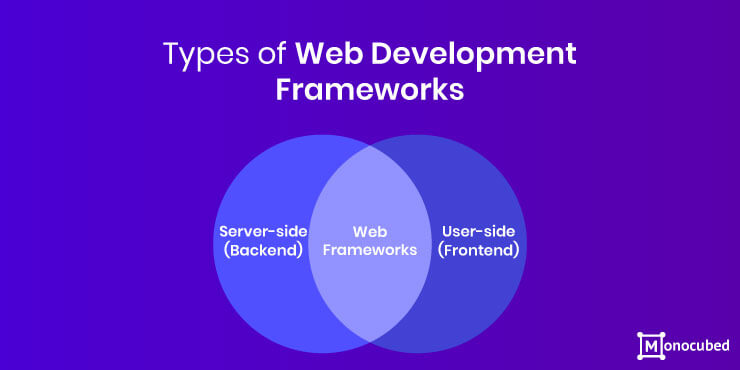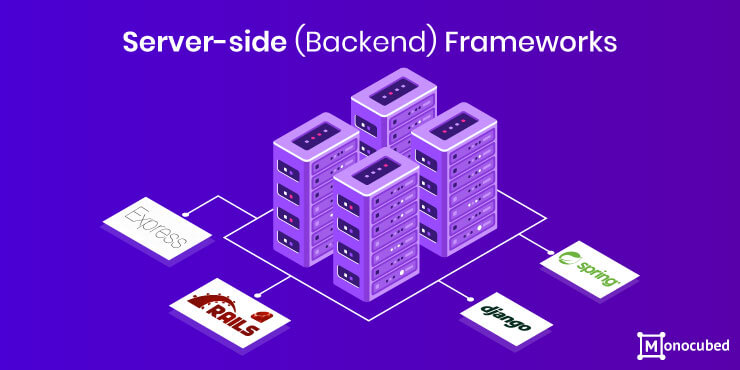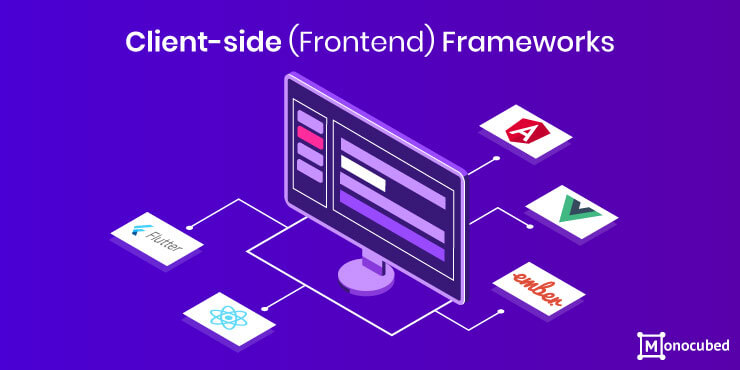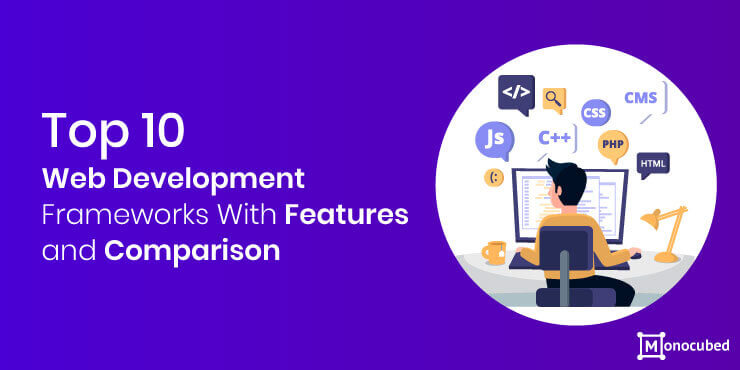Wondering which are the best web frameworks to use in 2022? Should you use the most popular framework? Or the fastest? Or the smallest?
If you are plagued by such questions, this blog is for you.
We understand web development can be hard and how tough it is to choose a web development framework for a project. After all, the wrong framework can slow down your website, take up too many resources and affect your sales significantly.
To help you in choosing the right web development framework and web development tools, we have curated a table of popular web framework comparison with the help of our web developers.
Table of Content
Quick Web Framework Comparison
Without wasting time, let’s look at a quick comparison of web application frameworks of the 10 top web development frameworks of 2022. To make things simpler we have divided the top 10 into-
- 5 best frontend frameworks
- 5 best backend frameworks
5 Best Backend Framework Comparison Table
The table lists the pros and cons of the top 5 backend or server-side web development frameworks. These are used for developing the business logic of web applications.
| Backend Frameworks | Pros | Cons |
|---|---|---|
| Ruby on Rails |
|
|
| ExpressJS |
|
|
| Laravel |
|
|
| Spring |
|
|
| Django |
|
|
5 Best Frontend Web Frameworks Comparison Table
The following table depicts a detailed front-end web app framework comparison that can be explained d by considering their pros and cons. These web application frameworks are used for developing a rich user interface.
| Frontend Frameworks | Pros | Cons |
|---|---|---|
| React |
|
|
| Flutter |
|
|
| Ember |
|
|
| Vue.js |
|
|
| Angular |
|
|
Now we will look at each of these web application frameworks in detail, closely looking at their features and when you should use them.
But first, let’s have a brief look at what a web framework is and what is meant by backend and frontend frameworks.
What is a Web Framework?
A web development framework or web application framework is a software tool that is designed to build and run websites and web applications along with web services, web servers, web sources, web portals, and web APIs.
But why should you use a web framework?
There are many advantages of using web development frameworks –
- Increased productivity
- Rapid development
- Supports Debugging
- Reusable, clean and efficient code
- Easy to maintain
- Added security
What Are The Different Types of Web Development Frameworks?
Now, there are various forms of web frameworks and models available in the market for both static and dynamic web applications and websites.
Depending on your business requirements and goals, you can take the decision of choosing which type of framework is suitable from the below-mentioned example for your web application development.

There are two kinds of web frameworks:
- Server-side (Backend) – Basically, the background, inner workings of the application is the work of the backend framework.
- Client-side (Frontend) – What a user sees when they open the application, called frontend, which is the external part of a web application framework.
What is Backend Framework?
Server-side or Backend frameworks are for the backend development of websites and web applications. They control the database, the application logic, the payment methods, the security and server configurations.
With the backend web framework rules and simple architecture, a developer’s productivity can be increased as they can create simple website pages, landings, and different forms of databases with existing templates.

In fact, developers and contributors can also shape the output results and help them improve the security mistakes occurring due to cross-site scripting in web development.
Form validation is also a beneficial functionality provided by server-side web framework for people requiring the user to input data structures that are estimated to meet definite necessities.
After all, to develop web applications to have an interactive interface, everyone will require a wider functionality and event handling.
In other words, all kinds of elements can definitely help you and developers simplify the process.
Server-side development frameworks work mostly individually but play an important role in application growth.
Examples of Backend Frameworks
-
Ruby on Rails Framework
Ruby on Rails (RoR) is a model view controller (MVC) framework written in Ruby programming language created by David Heinemeier Hansson.
It is known to be a beginner-friendly framework as it aids them to start web application development quite rapidly. Ruby on Rails presents various tools, abundant libraries and databases in order to lessen the amount of time.
It is also great on test automation which is a remarkable feature to check the quality of the software framework.
As a Ruby on Rails web development company, we use the framework for building cloud-based web applications, social networking websites, and eCommerce platforms.
Some examples of big companies that use Ruby on Rails are –
- GitHub
- Shopify
- Hulu
- Airbnb
- Pixlr
- ASKfm
There are countless beneficial gems of Ruby on Rails and library-like dependencies that emphasize the topics of the view layer and enhance the functionalities of your sites.
This facilitates the ability to build apps faster and more competently. The community of Rails is quite friendly and reliable, and many resources and tutorials assist you to become an expert in much less time.
Want to Test Your Idea Before Investing?
No worries. Get your idea validated by professionals. Develop a quick and affordable MVP with Ruby on Rails to test your web app idea.
-
ExpressJS Framework
ExpressJS is easy to use and maintain, particularly if you previously have knowledge of Node.Js. Simplicity and speed are the chief ideologies of this Node.js API development framework.
It delivers some essential topics without concealing the traits of Node and forces a robust presentation of asynchronous Node.js.
Express is also pretty flexible and aids in developing a web application, complete website, web page, and REST API.
Out of various open-source web frameworks, Express.js includes a huge number of exceptional web development tools and numerous solutions that can be created with just a few code lines.
It is also well-suited with supplementary frameworks like Sails, Loopback, and Kraken. You can augment HTTP and middleware technique routes, such as put, get, post, and something for that context, to a router like an application.
Nowadays, Express.js is swiftly becoming one of the best frameworks for web development. Some popular companies using Express.js are –
- IBM
- Uber
- Accenture
-
Laravel Framework
Laravel uses the PHP language and is a free and open-source web development framework. Laravel is backed by API support and it comprises several PHP components and packages that could outspread its influence.
Laravel 5.2 adds improvements to the web pages by providing implicit model binding, multiple authentication driver support, simplified Eloquent global scopes, and middleware groups.
It also comes equipped with opt-in authentication scaffolding, array validation improvements, rate limiting middleware, and more, which makes it ideal for eCommerce websites.
This MVC architectural pattern framework, created by Taylor Otwell, has sought the place of the most popular PHP frameworks.
The Laravel team also provides Laracasts, which are screencasts tutorials websites with copious videos on Laravel, front-end technologies, and PHP frameworks in the Laravel environment that could be beneficial for any beginner.
Entire Laravel source codes can be fetched through GitHub under the terms and conditions of the MIT license.
Laravel is one of the best web development frameworks for a quick and efficient web application.We provide profound Laravel development services with well documented details and fastest building cycle.
-
Spring Framework
Spring is based on Java and has an MVC framework developed by Pivotal software. The foremost purpose of this framework is the capabilities to make the formation of J2EE applications.
Its organized architecture and HTTP Post simplifies the whole procedure a lot. Many prominent corporations appreciate the benefits of Spring MVC and controller classes.
Some companies using the lightweight and minimalistic approach of Spring for building robust websites-
- BillGuard
- Wix
- TicketMaster
It is a lightweight container and offers API responses for numerous domains which are highly advantageous to websites and web developers.
Spring framework features have the advantages of retaining many parallel projects and enhancing their functionality that facilitate you in scaling up your business response speedily.
Its exemplary features such as the employment of Java, a powerfully typed programming language, make it one of the best web development frameworks.
-
Django Framework
Django is based on the Python full-stack web framework and is open-source. This Model View Template pattern(MVT) is considered to be one of the best architecture designs for web frameworks.
It supports Python version 3.4 and database access and produces an admin panel for constructing the websites built with Python language.
Its batteries-included trait offers a variety of properties that consist of messaging and authentication. It follows the Convention over Configuration philosophy and DRY concepts.
Django web framework offers tools and devices for developers to form a secure website, handle user accounts, and implement security features in the framework itself, like averting code performance in the templates layer.
Some of the top companies that use Django for creating websites-
- YouTube
What is Frontend Framework?
Frontend development focuses on the creation of an enriching user experience. The frontend web framework enables the manipulation of the look and feel of your website to specifically cater to the preferences of your viewers.
Contrasting to the backend, client-side frameworks only work inside the web browser. Thus, it allows the improvements of the website and the implementation of new web and user interfaces.
In fact, with such front-end web app frameworks, developers can create various animated features for single-page web applications. Adding creative graphics and creating a brand for your company.

Since frontend tools mainly work with the browsers, managing server requests, building a user interface, and handling thousands of user requests are the basic requirements from a front-end framework.
Each front-end frameworks have different deployment and links. While some are just libraries of UI components, others come equipped with form validations, database manipulations and interactions with the backend for a more complete approach to web page development.
Examples of Frontend Frameworks
-
React Framework
Although several developers treat it like a framework, React is a JavaScript frontend library.
According to stateofJS, React.js is the most popular web development framework for JavaScript owing to its ground-breaking component-based architecture.
React.js features permit comparative straightforward and quick user interface formation which is its central purpose of usage.
This MVC framework was established and maintained by Facebook. Apart from Facebook, other companies using React are –
- Codeacademy
- Netflix
- UberEats
Another important feature of React is React Fiber. It is a completely backward-compatible rewrite of the old reconciliation algorithm. React Fiber is changing the core of React from its representation of the DOM tree to stack callbacks. It introduces React developers to an easier way of introducing animations, layouts, and gestures.
On top of this, React.js also employs JCX syntax which makes the DOM manipulation faster than it typically is.
One of its focal application parts is its interface creation, and also mobile application development for Android and iOS using React Native.
-
Flutter Framework
Flutter is completely JavaScript-free as it is a framework written in Dart, a language created by Google for building server-side web apps for a desktop application.
It is a Google product that can be implemented to develop mobile iOS and Android applications, as well as to create network applications for Google Fuchsia OS.
Various websites that use Flutter-
- Tencent
- Alibaba
Furthermore, this language does not require any UI components as they were applied in Flutter previously. That is how games and other web applications written in this framework attain their greatest speed.
In addition to this, the widgets are supplied only when it is needed. The Hot-Reload scheme aids the platform to re-create and focus the widget tree from the beginning.
-
Ember Framework
Ember.js is one of the most trusted JavaScript web development frameworks. This MVC framework was released in 2011 and has been quickly gaining and growing more influence in the tech world.
Its community is massive, and it is continuously expanding, with its new features and release that are added regularly.
Ember has a 2-way user data migration utility and binding that Angular claims, and it offers numerous traits and components that you can deploy explicitly.
Companies that use Emberjs in their websites-
- Heroku
- Netflix
- Microsoft
Ember eliminates tasks that require much time and adopts JavaScript practices in its central design. This language lets you make assets out of functions which is quite advantageous when it comes to functioning with bindings.
The core characteristics are its advanced version management system, support of both the most modern standards and older technologies, and strict organization.
-
Vue.js Framework
Vue.js is quickly becoming to be the most popular JavaScript framework. It is an advanced framework that permits you to adapt Vue for one section of the existing idea and the rest everything would run as stated originally.
Owing to its simple construction, it solves any complexity easily. Vuejs features also render the component-based design to run, and the ecosystem can aid you to develop frontend applications.
Its lightweight, minimalistic, efficient approach to building the frontend is fast gaining traction. The many lists of its features include-
- Virtual DOM
- Two-way data binding
- Simplicity
- Flexibility
- View-layer focused framework
There are also many frameworks for Vue development available in the market. It is no surprise that in such a short time, Vue has become a part of the top 3 JavaScript frameworks, including long-standing React and Angular.
-
Angular Framework
Angular is considered to be the best web framework for developing rich single-page web apps(SPAs). As a Angular app development company, we prefer Angular because of its ability to develop responsive client-side apps.
Angularjs 1.x is used in JavaScript (JS), but the latter releases adapted TypeScript, which is a superset of JS. It was developed by Google.
Companies using Angular are –
- PayPal
- Microsoft
It needs less care and presents high-level performance because of its rich features such as dependency injection and 2-way data binding.
Some other characteristics that boost productivity and speed are command-line tools (CLI) and template syntax that sanctions quick prototyping.
Want a Custom Software Solution?
Get an affordable web-based software solution that is feature-rich, scalable, and integrable with your existing systems. Tailored to your requirements.
Things to Check Before Choosing a Web Framework
The intent to choose the right framework for web development will depend on many different factors and ideas that you need to consider before moving ahead and investing the cost required.
To save your time and effort below is the criteria that you need to consider before selecting an ideal web development framework for your upcoming activities involved in the project:
- How old is the development framework?
- Is it an open source option?
- Consideration of licensing
- Documents and plugins availability
- Ease of beginners, start-up and learning curve patterns
- Options of default unit testing systems
- Security and protection features
- Future application maintenance, trends, and support
Frequently Asked Questions
What are the frameworks in web application development?
The framework for developing web apps has a software bundle or tool that is designed to help the procedure of web apps such as web services, web resources, webpages, browsers, and web APIs. Developers’ teams use top website development frameworks and models to provide a convenient manner to develop and deploy web applications on the internet.
What are the kinds of web frameworks?
There are two kinds of frameworks available- backend and frontend. A backend web framework functions in the internal part of the application and frontend framework and link as an external section of the web application majorly what users and customers view when they open an application.
Which is the best web application framework for web design?
Every framework has its uniqueness that is why developers use it. In this situation, telling which is the best framework for web development of websites among various frameworks and models is very difficult. Defining the best development framework completely depends on your enterprise requirement and the project needs.
Conclusion
As we have discussed, the frontend and backend web development frameworks act as an important element in developing websites and web applications and there are some of the most popular web frameworks that you can choose for your upcoming project.
No doubt the selection of the best web development framework for a website must be based on the details of a specific project. Every enterprise and every person thinking about a web application framework may hold different influences.
We have given a fair comparison of web frameworks in this article. If you are still unsure where to start or are stuck in the middle procedure, contact us.
Monocubed, a professional web application development company can help you and your team with your web projects.
 By Jeel Patel
By Jeel Patel



